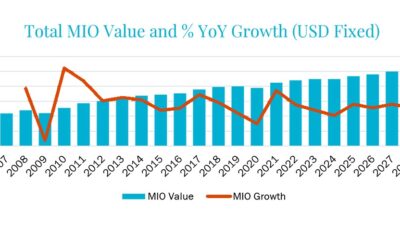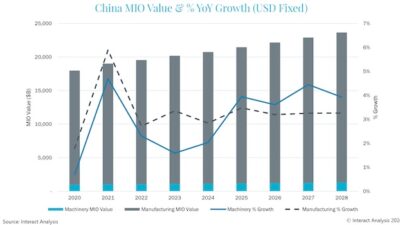Coronavirus is having a major effect on Chinese manufacturing in the short-term, but the long-term effects remain uncertain as the virus continues to have a global impact.

The Chinese economy, which experienced a difficult 2019 due to slowing domestic consumption and the impact of the Sino-US trade war, is once again facing more disruption and uncertainty at the hands of the coronavirus pandemic.
- Whether the epidemic can be effectively contained – and how long this takes – will largely determine the impact on China’s economy.
- Short-term impact to China’s manufacturing industry to be relatively large, whilst the medium and long-term impact more limited.
- When production lines and factories can resume work is the biggest variable as delay in resumption of work will cause production loss and supply risk.
- Although Hubei Province is now the epicenter that accounts for over 70% of the confirmed cases, its impact on the entire Chinese manufacturing industry is limited as its share in the country’s manufacturing industry is small, and the impact will be concentrated in several key industries in this region. Up to now, the automobile industry is the most affected.
Impact of 2019-nCoV on China’s Economy
According to the update from National Health Commission of the People’s Republic of China, as of February 10, 2020, a total of 40,235 cases of new coronavirus pneumonia had been confirmed nationwide, more than 4.5 times the number of confirmed cases of SARS in 2003. The number is still growing, and the duration of the epidemic is still difficult to predict. Hubei is the most severely hit province of the epidemic, accounting for over 70% of the confirmed cases, and its epicenter is in Wuhan (See Figure 1).
Whether the epidemic can be effectively contained – and how long this takes – will largely determine the impact on China’s economy. In the short term, February 10 is a relatively important date, because most enterprises resume normal work on that day. Although it means that the production and social activities that have been suspended for two weeks will gradually return to a normal rhythm, it also means greater challenges and tests, because the movement of people may bring a new wave of infection, so that the epidemic continues.
Domestic production and consumption have plummeted in the past two weeks, as the epidemic has required large-scale restrictions on the movement of people. Investment, consumption and exports will all be strongly impacted by the epidemic, and in the short term, it may also lead to increased unemployment and commodity prices. China’s GDP growth in the first quarter is expected to be around 2 percentage points lower than the same period in 2019 (6.4% for 2019 Q1). If the epidemic outbreak peaks in March, the most severe impact will be confined to the first quarter. The economy will likely continue slowing in the 2nd quarter but in the second half of the year the fiscal and monetary policy would likely cause a strong rebound. In such a scenario, the annual GDP growth could still be expected to exceed 5%.
The impact on China’s manufacturing industry
We expect the short-term impact to China’s manufacturing industry to be relatively large, whilst the medium and long-term impact more limited. When production lines and factories can resume work is the biggest variable (See figure 2). Here are three possible outcomes:
- Scenario 1: Complete resumption of work by the end of February would lead to <0.5% decrease in the machinery sector for 2020, and about a 1% decrease in industry production (industrial added value growth rate)
- Scenario 2: Complete resumption of work delayed until mid-April – <1% decrease in machinery sector of for 2020, about 1%-2% decrease in industry production (industrial added value growth rate)
- Scenario 3: The epidemic continues to spread, some manufacturing enterprises still can’t resume work before mid-April – >1% decrease in machinery sector for 2020, >2% decrease in industry production (industrial added value growth rate)
Delay in resumption of work will cause production loss and supply risk.
In order to prevent a further spread of the epidemic, the State Council announced an extension of the national Spring Festival holidays from 20th January – 30th January to 20th January – 2nd Feb, and most provinces extended the date of return further to 10th February. Nationwide mobility restrictions and quarantine for nearly two weeks has put forward a very serious challenge for the resumption of production.
Resuming production may be impacted by the following factors:
- Enterprises in the heavily infected areas such as Hubei Province are obviously unable to resume work smoothly on 10th Feb as they face much more uncertainties with the epidemic and need to make sure they can keep it well under control first.
- With a large number of people returning to work from their hometowns all over China, the increased mobility of people and the increased density of people in public places has raised the risk of the spread of the epidemic.
- If there are confirmed cases of the virus in factories or enterprises, they will face the measures of a shutdown and staff isolation for two weeks, and businesses must be extremely cautious in determining the time to resume work in the face of such risks.
Therefore, even if most enterprises begin to resume work after February 10th , the rate of actual staff arrival can only be gradually increased.
For some highly automated industries or enterprises (such as semiconductor, flat panel & display), even in the past 2 weeks, their production activities have been running as normal, and not affected by the epidemic interference. But those industries with large numbers of workers, and a lower degree of automation (such as electronics manufacturing) will face great challenges. After the wave of resumption of work, labor-intensive manufacturing will face a higher uncertainty because of the epidemic.
In addition, apart from Hubei Province which has the highest number of confirmed cases, the number of confirmed cases in the coastal areas of Zhejiang and Guangdong province is also high, and the local government’s control measurements are extremely strict. Many cities completely cut off transportation and postponed the date of resumption of work to even later in February. These two provinces have larger manufacturing clusters than Hubei, and the proportion of manufacturing exports in these places is also very high. Although it is too early to judge how far the impact will be felt, this potential risk may cause greater losses and is also likely to impact the global manufacturing supply chain.
Disruption to the supply of raw materials and products.
The current risk is mainly due to delays in the transport of components and raw materials. Due to transportation and quarantine restrictions, the transportation of domestic raw materials is affected, and also the speed of customs clearance. This will cause tight supply, and then the price of raw materials to rise. Meanwhile, as end-user demand weakens, many manufacturing companies are also facing the risk of higher inventory backlog, which may lead to passive production reduction.
In the short term, with the gradual recovery of logistics and the resumption of personnel, the pressure will ease. However, if the resumption of production is further delayed, shortages in raw material and component supply will start to occur. At present, this problem is more concentrated in automotive, electronics, steel and some chemical industries.
Overall, supply chain challenges are still largely under control. But in any case, the impact from supply chain will squeeze the profits of manufacturing enterprises.
Demand, decline and delay in personal consumption will have impact on consumer goods
The Spring Festival is traditionally a peak season for demand of consumer goods. But for this year, consumption has been almost non-existent. Furthermore, as personal income is expected to decline due to the virus, consumption will also therefore slow down. For example, the epidemic will inevitably affect the release of 5G mobile phones, and then affect the entire mobile phone industry chain. The already bleak car market has seen all offline marketing activities cancelled, and post-holiday car purchase plans have been widely postponed.
Impact from Wuhan/Hubei on manufacturing
Being the virus’ epicenter, manufacturers in the Wuhan/Hubei region have been most directly and severely affected by the outbreak. Tighter traffic and movement controls, as well as greater uncertainty about when to return to work and how to hire workers after the Lunar New Year, will amplify the impact on local manufacturing and spread to both upstream and downstream of related products and industries. In addition, Hubei and its bordering Hunan and Henan provinces are major labor export provinces in the manufacturing industry. The long shutdown period coupled with labor shortages and rising labor costs after the resumption date may cause a huge cash flow impact on many private enterprises.
Hubei accounts for about 4% of the country’s manufacturing industry, while Wuhan, Yichang and Shiyan are the top three cities in terms of manufacturing strength in the whole province. In terms of scale of manufacturing, Hubei is far smaller than that of the Yangtze River Delta and Pearl River Delta regions, so the impact on the entire Chinese manufacturing industry is limited, and the impact will be concentrated in several key industries in this region, including automobiles, flat panel displays, semiconductors etc.. Up to now, the automobile industry is the most affected.
Hubei is one of the four major automobile production bases in China. In 2019, Hubei produced 2.24 million cars, accounting for 8.8% of the country’s total. Wuhan is one of the four major passenger car bases in China. In addition to Dongfeng Motor Group, it also hosts major car manufacturers from Japan, the United States, France, the United Kingdom. In addition to that, half of the world’s top 20 tier-one auto parts companies such as Webasto, Bosch, Valeo and ZF all have offices or production bases located there. After the closure of Wuhan, many automobile companies have launched emergency measures, including evacuation of employees and their families, quarantine and observation, cancellation of travel between Wuhan and so on. The automobile production industry chain in Wuhan/Hubei and other regions will be temporarily suspended, and the resumption time will be further delayed, which will impact the domestic automobile and even the global automobile supply chain in the short term, and the supply of parts and components will be interrupted. It will also lead to the delay of new product development, testing and certification, production and product release.
In addition to automobiles, Wuhan is also an important base for the following industries:
- Optoelectronics and information industry: Wuhan is the largest producer of optical fiber and cable in the world, accounting for 2/3 of the domestic market and 1/4 of the international market. The relatively high level of automated production of optical fibre and cable manufacturing enterprises will help to speed up the resumption of production; on the other hand, for optical module products, although 2020 is a big year for the rollout of 5G networks, as it has not yet entered the stage of large-scale construction, the epidemic should have limited impact, and the impact caused by the delay in resumption of production may only cause the conversion of some orders.
- Flat panels and display. There are some leading display manufacturers in Wuhan including BOE, TCL (China Star Optoelectronics) and Shenzhen Tianma, all have made tens of billions RMB of investments in their factories. These enterprises are highly automated and should maintain normal production and operation of factories and minimize the impact from the epidemic. Part of the production material supply may be delayed due to logistics issues, but the overall impact is limited.
- There are some local leading semiconductor manufacturers having wafer plants in Wuhan, including Yangtze Memory Technologies, Wuhan Xinxin, Wuhan Hongxin. Due to the very high degree of automation, these enterprises can basically guarantee normal production and operations.
Trade implications
The World Health Organization (WHO) has determined the outbreak of coronavirus 2019 in China is a public health emergency of international concern (PHEIC). After the statement was announced, some overseas countries have made strict restrictions on people travelling and many overseas airlines have suspended flights to/from China, but so far it has not impacted the level of restrictions on trade in goods. If the epidemic is effectively controlled in February, then the epidemic area will only be concentrated in Hubei Province and the impact on trade will be relatively limited. However, if the epidemic continues and Guangdong, Zhejiang and other major trading provinces have more serious epidemics, the expansion of the scope of the epidemic area will have a direct impact on domestic exports because of trade restrictions.
Based on the above factors that will have an impact on manufacturing output, analysis on the impact on growth rates by industry, and impacted industries rank in figure 3.
See more stories about how the coronavirus and Covid-19 are impacting manufacturing below.



